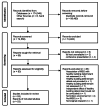Relationship of Healthy Building Determinants With Musculoskeletal Disorders of the Extremities: A Systematic Review
- PMID: 37091490
- PMCID: PMC10115431
- DOI: 10.7759/cureus.37456
Relationship of Healthy Building Determinants With Musculoskeletal Disorders of the Extremities: A Systematic Review
Abstract
Musculoskeletal disorders (MSDs) are a substantial societal burden and various factors affect their causation, recovery, and prognosis. Management of MSDs is complex and requires multifaceted interventions. Given the challenges of MSDs and their continued burden, it is possible that additional elements could impact these disorders that have not been fully researched, for example, indoor environmental quality. Our previous review provided preliminary evidence that healthy building determinants (HBDs) are associated with the risk of back and neck pain. However, the relationship of HBDs with extremity MSDs and general MSDs (i.e., MSDs involving multiple body regions or in which body regions were unspecified in the original reports) has not been formally studied. The purpose of this review was to conduct a systematic literature review to assess the relationship of HBDs with extremity and general MSDs (PROSPERO ID: CRD42022314832). PubMed, CINAHL, Embase, and PEDRo databases were searched through April 2022. Inclusion criteria for study eligibility were as follows: humans of ages ≥18 years, reported on one or more of eight HBDs (1. air quality and ventilation, 2. dust and pests, 3. lighting and views, 4. moisture, 5. noise, 6. safety and security, 7. thermal health, 8. water quality), and compared these HBDs with extremity MSDs or general MSDs, original research, English. Exclusion criteria were as follows: articles not published in peer-reviewed journals, full-text articles unavailable. Review procedures were conducted and reported in accordance with Preferred Reporting Items for Systematic Reviews and Meta-Analyses (PRISMA) recommendations. Empirical evidence statements were developed for 33 pairwise comparisons of HBDs with MSDs. The search uncovered 53 eligible studies with 178,532 participants. A total of 74.6% (39/53) of the studies were cross-sectional and 81.1% (43/53) were fair quality. Overall, the majority of uncovered evidence indicates that HBDs are related to risk of extremity and general MSDs. Nineteen comparisons support that as HBDs worsen, the risk of MSDs increases. Six comparisons had conflicting evidence. Three comparisons support that poor HBDs are not related to increased risk of extremity and general MSDs. Five comparisons had no evidence. This systematic review builds upon previous work to provide useful starting points to enhance awareness about the HBD-MSD relationship. These findings can help inform research and public health efforts aimed at addressing suboptimal HBDs through appropriate interventions to improve the lives of those suffering from MSDs.
Keywords: built environment; extremities; healthy buildings; indoor environmental quality; musculoskeletal disorders.
Copyright © 2023, Gherscovici et al.
Conflict of interest statement
The authors have declared financial relationships, which are detailed in the next section.
Figures
References
-
- The burden of musculoskeletal diseases in the United States. [ Jun; 2022 ]. 2014. http://www.boneandjointburden.org http://www.boneandjointburden.org - PubMed
-
- Washington, DC: National Academies Press; 2020. Selected Health Conditions and Likelihood of Improvement with Treatment. - PubMed
-
- Discord between approaches to spinal and extremity disorders: is it logical? Jull G. J Orthop Sports Phys Ther. 2016;46:938–941. - PubMed
Publication types
LinkOut - more resources
Full Text Sources
Miscellaneous

